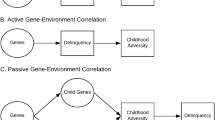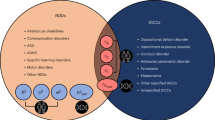Abstract
Disregard for rules, a key component of oppositional defiant and conduct disorders, is stable during early childhood. This study investigates for the first time the relative importance of genetic and environmental factors underlying this early developmental stability. Maternal reports of child disregard for rules were obtained at four time points from 20 to 64 months of age in a population-based twin sample (N = 597 twin pairs, including 238 monozygotic and 359 dizygotic pairs). Structural equation modeling was conducted using both variance–covariance and latent growth curve approaches. Genetic factors accounted for most of the stability in disregard for rules throughout early childhood. In contrast, most environmental effects were age specific. Developmental stability in early symptoms of disregard for rules is best explained by the stable action of genetic factors, suggesting that preventive interventions should take an intergenerational approach, targeting at-risk families as early as possible.


Similar content being viewed by others
Notes
Simplex models, in which genetic (or environmental) correlations are strongest between adjacent assessments (Boomsma and Molenaar 1987), were also tested, and results are available in the Electronic Supplementary Table. However, since the final, reduced models did not follow a simplex structure, these models are not discussed to avoid unnecessary complexity.
References
Achenbach TM, Rescorla LA (2000) Manual for the ASEBA preschool forms and profiles. Research Center for Children, Youth, & Families, University of Vermont, Burlington
Boomsma DI, Molenaar PCM (1987) The genetic analysis of repeated measures. I. Simplex models. Behav Genet 17(2):111–123
Caspi A, McClay J, Moffitt TE, Mill J, Martin J, Craig IW, Taylor A, Poulton R (2002) Role of genotype in the cycle of violence in maltreated children. Science 297(5582):851–854
Clark LA, Watson D (1995) Constructing validity: basic issues in objective scale development. Psycho Assess 7(3):309–319
Côté SM, Boivin M, Nagin DS, Japel C, Xu M, Zoccolillo M, Tremblay RE (2007) The role of maternal education and non-maternal care services in the prevention of children’s physical aggression problems. Arch Gen Psychiatry 64(11):1305–1312
Deater-Deckard K (2000) Parenting and child behavioral adjustment in early childhood: a quantitative genetic approach to studying family processes. Child Dev 71(2):468–484
Derks EM, Hudziak JJ, Van Beijsterveldt CEM, Dolan CV, Boomsma DI (2004) A study of genetic and environmental influences on maternal and paternal CBCL syndrome scores in a large sample of 3-year-old Dutch twins. Behav Genet 34(6):571–583
Forget-Dubois N, Pérusse D, Turecki G, Girard A, Billette J-M, Rouleau G, Boivin M, Malo J, Tremblay RE (2003) Diagnosing zygosity in infant twins: parent report, DNA analysis, and chorionicity. Twin Res 6:479–485
Goldsmith HH (1991) A zygosity questionnaire for young twins: a research note. Behav Genet 21:257–269
Gregory AM, Eley TC, Plomin R (2004) Exploring the association between anxiety and conduct problems in a large sample of twins aged 2–4. J Abnorm Child Psychol 32(2):111–122
Hudziak JJ, Derks EM, Althoff RR, Copeland W, Boomsma DI (2005) The genetic and environmental contributions to oppositional defiant behavior: a multi-informant twin study. J Am Acad Child Adolesc Psychiatry 44(9):907–914
Kaler SR, Kopp CB (1990) Compliance and comprehension in very young toddlers. Child Dev 61(6):1997–2003
Kochanska G, Coy KC, Murray KT (2001) The development of self-regulation in the first four years of life. Child Dev 72(4):1091–1111
Kowaleski-Jones L, Dunifon R (2004) Children’s home environments: understanding the role of family structure changes. J Family Issues 25:3–28
Kuczynski L, Kochanska G (1990) Development of children’s noncompliance strategies from toddlerhood to age 5. Dev Psychol 26(3):398–408
McArdle JJ, Hamagami F (2003) Structural equation models for evaluating dynamic concepts within longitudinal twin analyses. Behav Genet 33(2):137–159
McGowan PO, Sasaki A, D’Alessio AC, Dymov S, Labonté B, Szyf M, Turecki G, Meaney MJ (2009) Epigenetic regulation of the glucocorticoid receptor in human brain associates with childhood abuse. Nat Neurosci 12(3):342–348
Neale MC, Boker SM, Xie G, Maes HH (2003) Mx: statistical modeling, 6th edn. VCU Department of Psychiatry, Richmond
Neale MC, Roysamb E, Jacobson K (2006) Multivariate genetic analysis of sex limitation and GXE interaction. Twin Res Hum Genet 9(4):481–489
Olds DL, Sadler L, Kitzman H (2007) Programs for parents of infants and toddlers: recent evidence from randomized trials. J Child Psychol Psychiatry 48(3/4):355–391
Patterson GR (1982) Coercive family processes. Castalia, Eugene
Petitclerc A, Boivin M, Dionne G, Pérusse D, Tremblay RE (2008) Genetic and environmental etiology of continuity and change in early childhood oppositional, hyperactive and aggressive symptoms. In: Poster presented at the conference from Science to Practice and Back: Mechanisms of Change in Developmental Psychopathology, Hospital for Sick Children, Toronto, Canada, October 17, 2008
Petitclerc A, Boivin M, Dionne G, Zoccolillo M, Tremblay RE (2009) Disregard for rules: the early development and predictors of a specific dimension of disruptive behavior disorders. J Child Psychol Psychiatry 50(12):1477–1484
Reynolds CA, Finkel D, McArdle JJ, Gatz M, Berg S, Pedersen NL (2005) Quantitative genetic analysis of latent growth curve models of cognitive abilities in adulthood. Dev Psychol 41(1):3–16
Schmitz S, Fulker DW, Mrazek DA (1995) Problem behavior in early and middle childhood: an initial behavior genetic analysis. J Child Psychol Psychiatry 36(8):1443–1458
Stipek DJ, Gralinski JH, Kopp CB (1990) Self-concept development in the toddler years. Dev Psychol 26(6):972–977
Tremblay RE (2010) Developmental origins of disruptive behaviour problems: the ‘original sin’ hypothesis, epigenetics and their consequences for prevention. J Child Psychol Psychiatry 51(4):341–367
van Beijsterveldt CEM, Bartels M, Hudziak JJ, Boomsma DI (2003) Causes of stability of aggression from early childhood to adolescence: a longitudinal genetic analysis in Dutch twins. Behav Genet 33(5):591–605
Acknowledgements
This research was supported by grants from the National Health Research Development Program (NHRDP), the Social Sciences and Humanities Research Council of Canada (SSHRC), the Canadian Institutes of Health Research (CIHR), the Canada Research Chair Program, the Fonds Québécois de Recherche sur la Société et la Culture (FQRSC), and the Fonds de Recherche en Santé du Québec (FRSQ). The first author was supported by scholarships from the Social Sciences and Humanities Research Council of Canada (SSHRC) and the Behavior, Gene and Environment Training Program. We are grateful to the parents of the children in the Quebec Newborn Twin Study (QNTS). We thank Nadine Forget-Dubois, Alain Girard, Bei Feng and Hélène Paradis for assistance with statistical analyses.
Conflicts of interest
The authors declare they have no financial relationships relevant to this article to disclose.
Author information
Authors and Affiliations
Corresponding author
Additional information
Edited by Valerie Knopik.
Electronic supplementary material
Below is the link to the electronic supplementary material.
Rights and permissions
About this article
Cite this article
Petitclerc, A., Boivin, M., Dionne, G. et al. Genetic and Environmental Etiology of Disregard for Rules. Behav Genet 41, 192–200 (2011). https://doi.org/10.1007/s10519-010-9393-6
Received:
Accepted:
Published:
Issue Date:
DOI: https://doi.org/10.1007/s10519-010-9393-6




